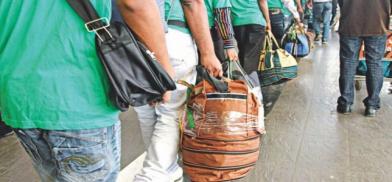Three-fourths of returnee migrants in Bangladesh struggling to find jobs
Around 77 percent of the migrants in Bangladesh who returned home due to the COVID-19 pandemic were struggling to find jobs, according to a study

Around 77 percent of the migrants in Bangladesh who returned home due to the COVID-19 pandemic were struggling to find jobs, according to a study.
Among the migrant households with returnees, 61 per cent had at least one member who lost a job or earning opportunity during the pandemic.
These are among the outcomes of research jointly conducted by BRAC – a Bangladesh-based international non-governmental organization - UN Women Bangladesh and the Center on International Cooperation at New York University.
The survey was conducted among 6,370 households during 10-25 December 2020 and considered April-November 2020 as the reference period, Prothom Alo reported.
The study focuses attention specifically to the impact of the COVID-19 on internal and international migration, including migrants who were forced to return to their places of origin due to various circumstances during the pandemic.
According to its findings, over three-fourth (77 per cent) of the marriages that took place in households during the surveyed period had brides who were under the age of 18, which is 26 percent higher than the national rate of child marriage (51 percent) in 2018.
Child marriages were found to be more prevalent in rural areas (81 percent) than in urban locations (70 percent).
The findings of the research titled “Demographic and socio-economic changes induced by the COVID-19 pandemic: Challenges of new circumstances” were unveiled at a virtual policy dialogue in Dhaka.
One-fourth (25 percent) of returnee migrant households are concerned about repaying their outstanding migration loans, which amount to an average of Tk 76,000 (around USD 900), and a maximum of Tk 700,000 (around USD 8,300), the study found.
Around 44 percent reported that they could not find any income-generating work and some of them are managing expenses by withdrawing from savings or using rent from assets.
The surveyed households reported a 58 percent decrease in monthly remittances received on average during the pandemic that is in stark contrast with the national reports of the higher flow of remittances during this period.
The study found that 4.57 percent amongst the returnee population was school-aged children (age 5 to 16 years).
If these children cannot return to their previous schools after those reopen, the educational institutions in localhost communities will be under pressure.
(SAM)









Post a Comment